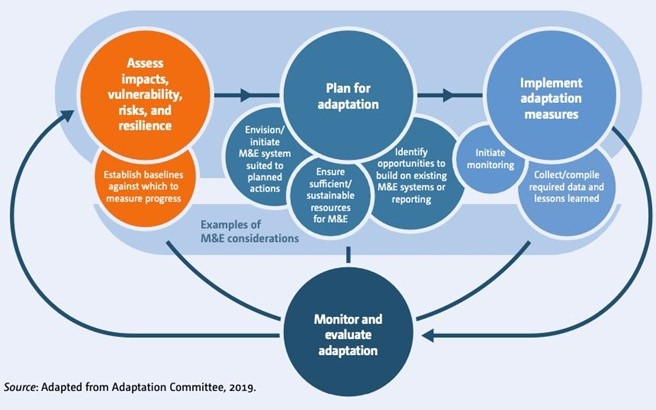Monitoring climate adaptation
Monitoring, reporting and evaluation on climate adaptation serves multiple purposes, such as tracing progress made, assessing what has been accomplished, and communicating the processes and outcomes of adaptation. It provides feedback on adaptation progress and performance, for example whether the adaptation goals, targets and efforts are sufficient, and how they contribute to reducing vulnerability to climate change. But the overarching goal of Monitoring-Reporting-Evaluation (MRE) of climate adaptation is to enable ‘new information and lessons learned to shape future decisions’.
Monitoring aims at mapping adaptation efforts through criteria or indicators and showcases changes over time. Reporting aims at showcasing and presenting the monitoring results to a broader audience and making experiences and lessons learned available for all kind of stakeholders. Evaluation classifies the mainstreaming efforts, e.g. based on different kinds of criteria/indicators.

The process of monitoring and evaluating adaptation
Monitoring is usually undertaken on an on-going basis while reporting and evaluation activities are typically only conducted at specific (usually strategic) points in time. The overall process can be split into four iterative phases.
Assessing impacts, vulnerability, risks and resilience
Initial and periodically updated assessments, grounded in systematic observations and the best available science, of how climate change is impacting natural and human systems, and how it is expected to impact these in future. It assesses the capacity of these systems to adapt to climate change impacts.
Planning for adaptation
Identify potential adaptation measures and evaluate them to prioritize and choose the most appropriate among available options. Adaptation planning requires avoid duplications, prevent maladaptation, and maximize synergies to maximize sustainable development outcomes.
Implementing adaptation measures
Implement adaptation initiatives at various levels and through a variety of means, including projects, programs, policies, or strategies. Increasingly, adaptation is pursued through mainstreaming initiatives into budgets, sectoral policies, and sustainable development plans.
Monitoring and evaluating (M&E) adaptation
It helps ensure that efforts are successful and that the knowledge and information generated from planning and implementation are fed back into the process. Monitoring keeps a record of progress made throughout the implementation phase, while evaluation seeks to determine the effectiveness of the initiative.
Summary
Reflection
- When should the monitoring phase take place in climate adaptation processes?
- What are the different functions between monitoring, reporting and evaluating?




